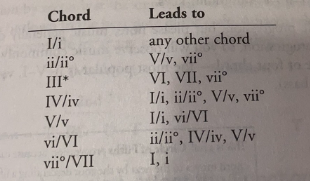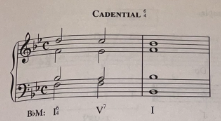Chapter 9 - Harmonic Progression and Harmonizing a Melody
Harmonic Progression
Harmonic progression - The process of relating chords within the scale to where they naturally lead.
Progression - When the harmonies proceed from a stable beginning (tonic function), move forward through progressively more active chords (predominant and dominant function), including seventh chords to end (resolve) with stability.

Circle Progression
Circle progression - The movement of chords where the root of each chord is a diatonic fifth above the next chord.
- Strongest motion in tonal music

The most common use of the vii° triad is in first inversion (vii°6) resolving to I or I6.

Progression by thirds - The movement of chords where the root of each chord is either up or down by a third.

Progression by seconds - The movement of chords where the root of each chord is either up or down to the next note in the scale.

How Does Inversion Affect the Function of a Chord in a Progression?
The more a chord is inverted, the weaker its function or the more it functions like another chord.
Types of second inversion chords
- Passing
- Pedal
- Arpeggiated

- Cadential

PROgression vs. RETROgression
- RETROgression - When harmonies move backwards from this concept T-D-S-T (a root position V to a root position IV).
- Don’t follow V with IV, ii6 or ii6/5.
- Don’t follow vi (VI) with I (i) because the tonic chord is more stable, less tense than IV.
- Don’t follow ii with IV. They’re not equal in tension.
Harmonic Rhythm
- Harmonic rhythm - The rate at which harmony changes.
- There’s no rules for this.
Fundamentals of Melodic Harmonization
The Process of Harmonizing a Melody
- Identify the notes of the melody with either scale degree numbers or solfege.
- Do the cadences first.
- Cadences end with I (i), vi (VI) or V only, so the chord symbols at the fermatas should only be a I, vi or V (i, VI or V in minor).
- Use root position chords for the final two chords in each of your cadences.
- Use the same process used to create an implied progression from the bass line to create a viable progression that goes with the melody.
- Don’t invert needlessly
- Don’t use seventh chords excessively
- Don’t use root-position vii° chords
- Don’t use non-chord tones excessively in the bass line
- Don’t use second inversion triads unless you understand the function
- Identify any notes out of the key and what that implies.
- Connect the dots between melodic patterns and implied harmonies.